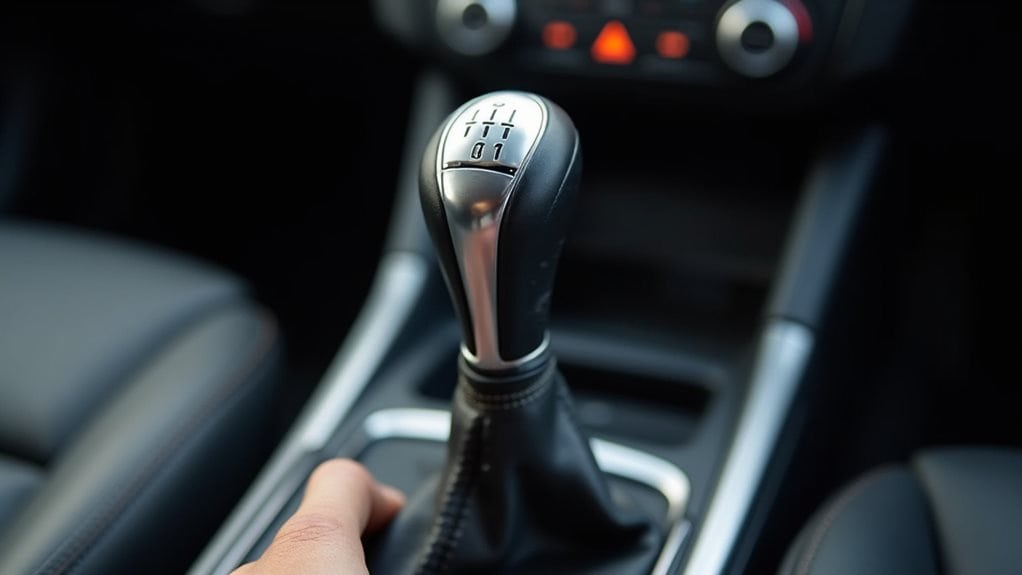If your transmission’s stuck in first gear, start by checking your transmission fluid level and condition while the engine’s warm and running on level ground. Look for bright red fluid within the dipstick’s marked range – dark or low fluid often causes shifting problems. Next, inspect for leaks around the transmission pan and cooling lines using cardboard underneath overnight. While these steps might solve basic issues, transmission problems often require deeper investigation to fully resolve.
Quick Tips
- Check transmission fluid level and condition – low or dirty fluid is a common cause of gear shifting problems.
- Verify if the vehicle has entered safety/limp mode by checking for warning lights and limited speed capabilities.
- Inspect for transmission fluid leaks by placing cardboard under the parked vehicle overnight.
- Use an OBD-II scanner to check for transmission-related error codes, particularly P0700 and P0731.
- Allow the engine to warm up properly before driving, especially in cold weather conditions.
Common Symptoms of a Stuck First Gear
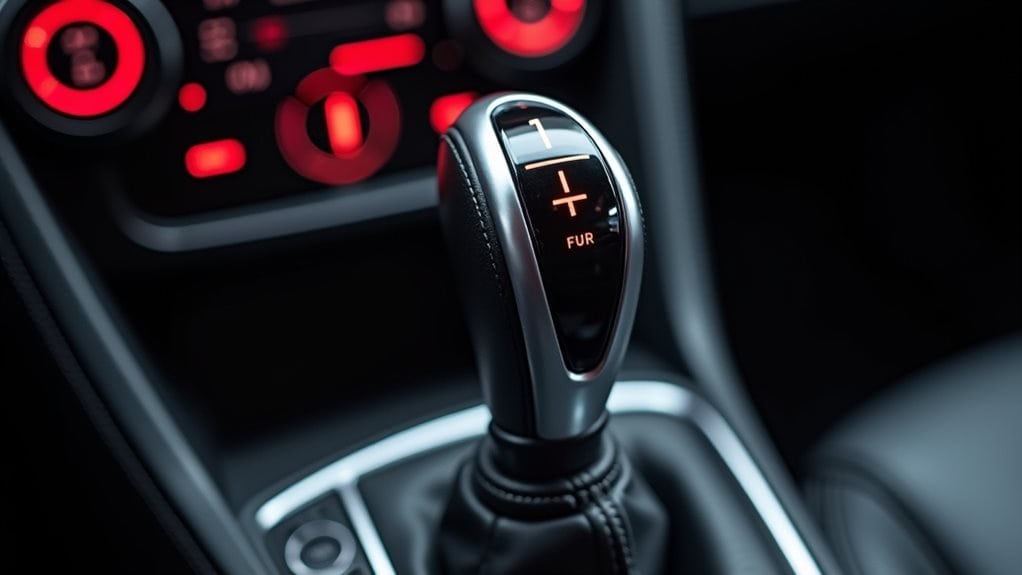
When your transmission gets stuck in first gear, you’ll notice several distinct warning signs that shouldn’t be ignored.
Your engine might rev unusually high without the vehicle gaining speed, while abnormal humming or buzzing sounds could accompany your attempts to shift. Low transmission fluid can also contribute to these issues, resulting in gears failing to engage properly.
You’ll likely experience sluggish acceleration, and your check engine light may illuminate.
Watch for jerky movements and delayed responses when shifting. For immediate assistance, consider joining DMCTalk.org forums where experienced DeLorean owners discuss transmission troubleshooting.
Understanding Your Transmission’s Safety Mode
Your transmission’s safety mode, also known as “limp mode,” will alert you through several key warning signs, including limited gear shifting, reduced speed capability, and an illuminated check engine light.
When these signals appear, you’ll notice your vehicle’s performance becomes particularly restricted, typically limiting you to first gear and speeds under 45 mph. This mode can be triggered by electrical issues that disrupt the transmission’s normal functioning.
While this protective feature might seem alarming, it’s actually your vehicle’s way of preventing potential transmission damage until you can get professional help. The transmission computer responds to sensor signals that fall outside acceptable ranges by activating this protective mode.
Safety Signals to Watch
A modern transmission’s safety mode serves as an intelligent defense mechanism, protecting your vehicle from potentially severe damage when problems arise.
You’ll notice key warning signs like limited gear shifting, reduced speed capability, and an illuminated check engine light.
Watch for unusual transmission behavior, and if your vehicle won’t shift beyond first gear, it’s likely entered safety mode to prevent further damage.
When Limp Mode Activates
Modern vehicles protect themselves through an intelligent safety system called limp mode, which triggers when your transmission faces potential risks.
You’ll notice reduced speed capability, limited RPMs, and possibly stuck gears. The system might disable auxiliary features like air conditioning while illuminating your check engine light.
When this happens, your vehicle’s protecting itself from potential transmission damage.
Quick Fluid Level Check Guide

Properly checking transmission fluid levels can prevent costly repairs and extend your vehicle’s lifespan.
Park on a level surface and locate the dipstick near where the transmission meets the engine.
With your engine warmed up and running (unless specified otherwise), pull out the dipstick, wipe it clean, reinsert it, and check that the reddish-pink fluid falls within the marked range. Regular checks of transmission fluid health are essential for ensuring smooth operation and preventing damage.
Signs of Faulty Shift Solenoids
When your transmission’s shift solenoids start to fail, you’ll notice your vehicle exhibiting erratic gear changes that feel rough or unpredictable.
Your car might hesitate or take longer than usual to respond when you’re trying to accelerate or change gears, which is a clear indication of shift solenoid problems.
In more severe cases, your transmission can become completely stuck in first gear, preventing any upshifts and potentially leaving you stranded if you don’t address the issue promptly. Additionally, a faulty starter can result in similar symptoms, emphasizing the importance of diagnosing electrical components in conjunction with transmission issues.
Erratic Gear Change Patterns
Since faulty shift solenoids often manifest through erratic gear changes, you’ll need to recognize several key warning signs to identify transmission problems early.
Watch for rough or unexpected gear shifts accompanied by clunking noises, sluggish acceleration, or your transmission getting stuck in a single gear.
You might also notice your engine revving high without moving forward, which indicates transmission slipping.
Delayed Shifting Response
A delayed shifting response in your transmission often signals underlying issues with shift solenoids, which are responsible for managing hydraulic pressure during gear changes.
You’ll notice signs like slipping between gears, erratic shifting patterns, and unusual noises during gear changes.
If your transmission hesitates or makes grinding sounds when shifting, it’s likely time to have your solenoids inspected by a professional.
Stuck in Single Gear
Because shift solenoids play an essential role in your transmission’s operation, getting stuck in first gear often indicates these components have failed.
You’ll notice your engine’s RPMs increasing without matching speed gains, and you might hear whistling sounds from the transmission.
Watch for rough shifting patterns or your vehicle entering limp mode, as these are telltale signs you’re dealing with faulty solenoids.
Electrical System Diagnostics
When your transmission won’t shift out of first gear, electrical system diagnostics serve as an essential first step in identifying the root cause of the problem.
You’ll need to check for faulty wiring, malfunctioning sensors, and corroded connections using a multimeter.
Start by retrieving error codes with a scan tool, then inspect individual components, focusing on transmission-related sensors and their wiring assemblies.
Checking for Transmission Fluid Leaks

To identify transmission fluid leaks, you’ll want to check common leak points including the pan gasket, input/output shaft seals, and cooler lines, where you might spot the telltale red or brown fluid dripping.
When inspecting for leaks, you can slide a piece of clean cardboard under your parked vehicle overnight to help pinpoint the exact location of any drips, as transmission fluid typically appears bright red when fresh and darker brown when aged.
Your visual inspection should also include examining the transmission pan for signs of damage or loose bolts, while paying close attention to any wetness around seal areas that could indicate a developing leak.
Common Leak Locations
Since transmission fluid leaks can quickly escalate into major repairs, knowing the common leak locations helps you identify problems early.
You’ll want to check your transmission’s drain plug and pan gasket first, as they’re frequent culprits.
Don’t forget to inspect the torque converter, transmission lines, and pan itself, which can be damaged by road debris.
Leak Color Identification
Identifying transmission fluid leaks starts with recognizing their distinctive color patterns.
Fresh transmission fluid appears bright red, while aging fluid darkens to deeper red or brown.
You’ll notice it’s thick and oily, similar to engine oil, with a distinct petroleum smell.
Don’t confuse it with other car fluids – coolant is typically green or orange, while brake fluid is yellowish.
Visual Inspection Methods
Now that you’re familiar with transmission fluid colors, a proper visual inspection will help you locate the exact source of any leaks.
Park your vehicle on a level surface and place white paper underneath the suspected leak areas. Check for wetness around gaskets, seals, and cooling lines.
You’ll also want to inspect the transmission pan for cracks and look for any corroded components.
Scanning for Error Codes
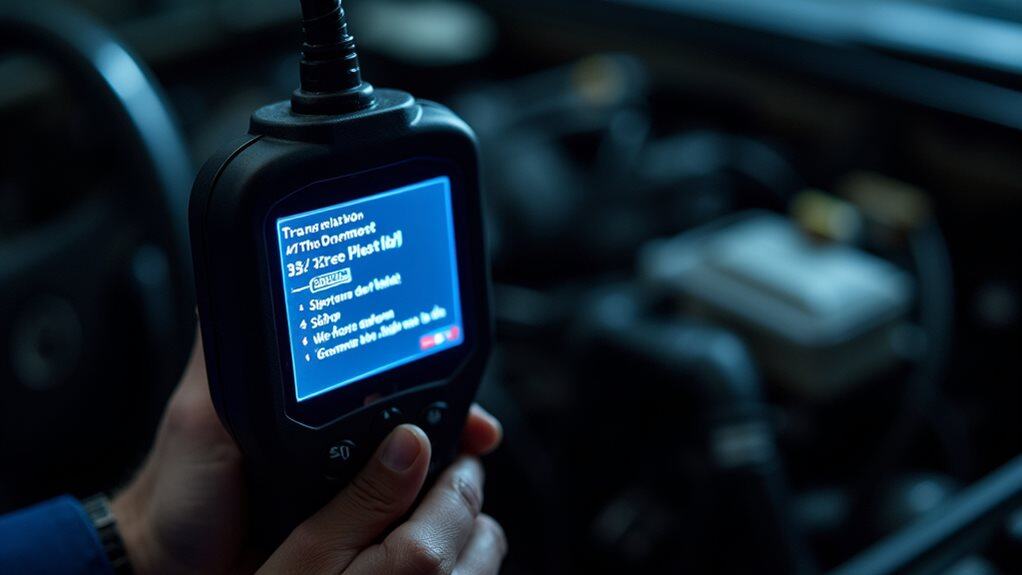
When your transmission won’t shift out of first gear, scanning for error codes should be your initial diagnostic step.
Using an OBD-II scanner, you’ll need to check for P-series codes, particularly P0700 for general transmission issues or P0731 for specific first-gear ratio problems.
Don’t overlook manufacturer-specific codes, which start with “1” instead of “0” in the second digit position.
Weather and Environmental Impact
Beyond error codes, environmental conditions play a significant role in transmission performance and can explain why your vehicle won’t shift out of first gear.
Cold weather thickens transmission fluid and causes components to contract, while extreme heat can lead to fluid breakdown.
You’ll notice these issues through delayed shifting, grinding noises, or complete failure to shift beyond first gear.
When to Call a Professional
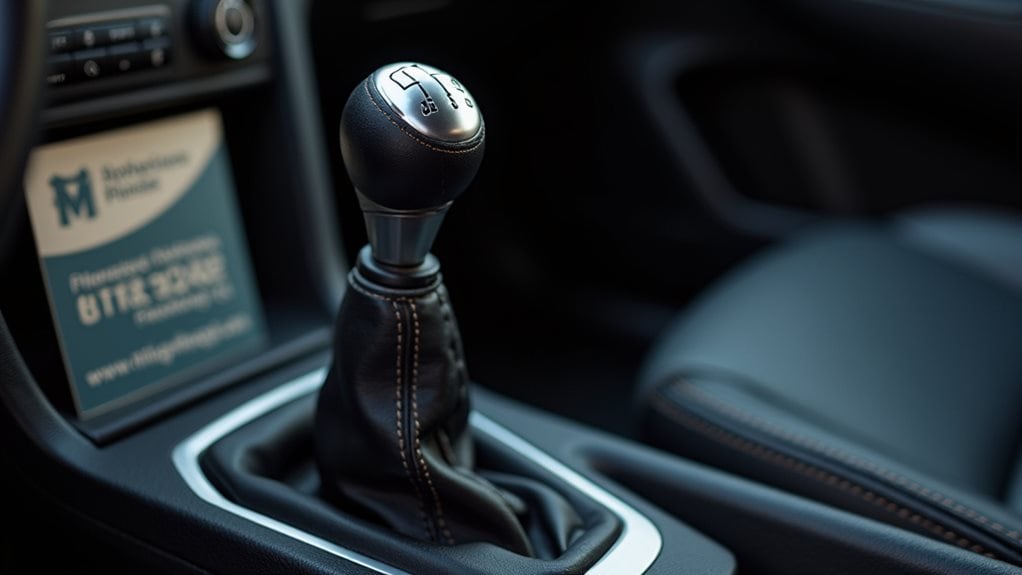
Recognizing your transmission’s warning signs is essential for determining the right time to seek professional help.
If you’ve noticed your car’s stuck in first gear, it’s best to have a professional mechanic assess the situation, as they’ll have the specialized diagnostic tools needed.
Don’t attempt complex transmission repairs yourself, as this can lead to more severe and costly damage.
Cost Analysis of Repairs
Now that you’ve decided to seek professional help, understanding the financial impact of transmission repairs will help you make informed decisions about your vehicle’s future.
You’ll need to budget between $300 to $1,500 for basic repairs, while a complete transmission replacement could cost you $2,500 to $5,000 for an automatic transmission.
If you’re considering a used transmission, you can save money with costs ranging from $800 to $1,500.
Preventive Maintenance Tips
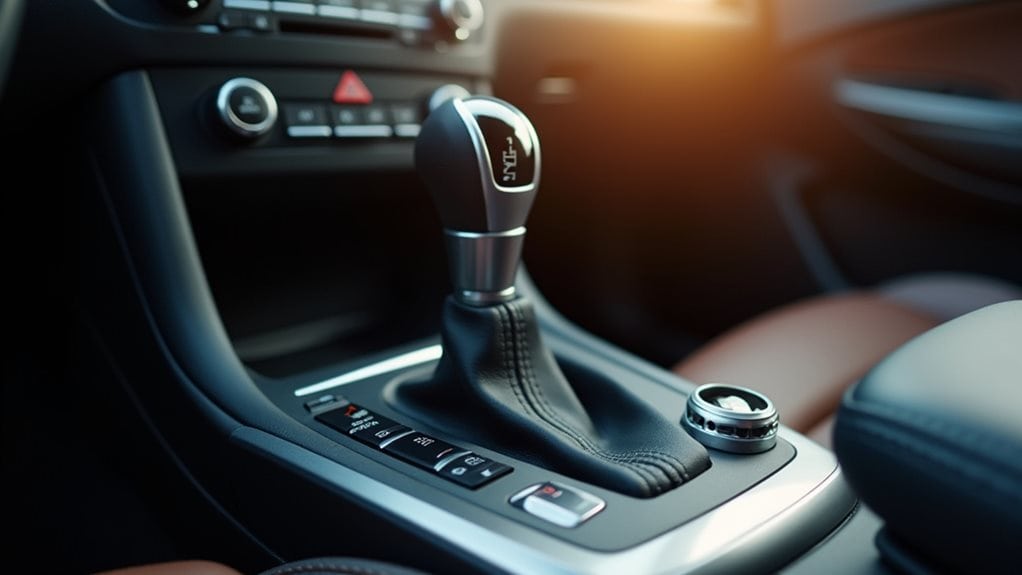
Regular preventive maintenance serves as your transmission’s best defense against costly repairs and unexpected breakdowns.
To protect your transmission, check fluid levels every few months, ensuring it’s bright red with a sweet smell.
Don’t skip manufacturer-recommended fluid changes at 30,000-60,000 miles, and let your engine warm up before driving.
Always use the correct transmission fluid type and have annual professional inspections.
Wrapping Up
When your transmission’s stuck in first gear, you’ll want to start with the basics: check your fluid levels and look for error codes before assuming the worst. If you’ve followed the troubleshooting steps and still can’t resolve the issue, don’t hesitate to consult a professional mechanic. Regular maintenance and prompt attention to transmission problems will help you avoid costly repairs and keep your vehicle running smoothly.

